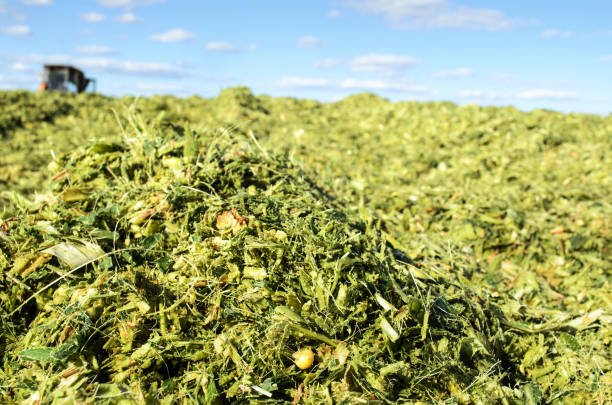
Overview
The main difference between corn silage and regular silage depends on their use, particular hybrid varieties, and harvesting method. Silage corn is harvested when the entire plant is used for animal feed and regular corn is harvested (small level business) for its dried kernels. The main difference is that corn silage is harvested as a whole plant to prepare animal feed, however regular corn is harvested for its grain that is used for other purposes.
Silage corn is first cut when the plant is wet, then chopped into small pieces, fermentation to preserve it for long-term consumption. On the other hand, regular corn is left to dry before kernels are separated from the cob.
Understanding Their Key Differences:
Corn is one of the most important cultivated crops all over the world, used as human food, animal feed, and industrial purpose. Regular corn is also called grain corn. But all corn is grown for different purposes. It is used as a basic source of calories for millions of people in regions like Africa. Both are grown, harvested and used in the same way but differently. In this post, we’ll highlight the different for buyers, feed producers, and farmers in the agricultural sector. It is compulsory for animal feed and a good source for industrial products such as starches, biofuels, and sweeteners. Its versatility makes it an important component in agricultural economy.
Global Significance
Pakistan generates money through corn silage crop as it supports million of farmers and so contributes to the economy. In production phase, you will face challenges from diseases, climate change, and pests, however; it is available in all types of updated varieties. Corn silage has importance all over the world due to cost-effectiveness and high-energy feed source for the beef and dairy industries. It remains available throughout the year. It can support weight grain and high milk production. It has multiple benefits and improves efficiency for farmers.
Nutritional and agricultural significance of Corn silage
- High energy and nutrients: Silage corn has energy and provides minerals (calcium, potassium, and phosphorus), vitamins, and proteins.
- Supports livestock performance: It can increase milk production in dairy cows compared to other animal feed items.
- Continuous and reliable feed: Acid is formed after ensiling process and make it easy to digest and preserves its nutrition.
Economic and trade Significance
- Cost Efficiency in Livestock Production: Corn silage helps in reducing dependency, like if you must buy animal food supplements. It’s about 70 percent feed is used for important purpose. To produce a high yields per acre, it will reduce overall cost.
- Enhanced Animal Productivity: to increase farm profitability and income, farmers should plan providing high energy for dairy animals or cattle.
- Year-Round Feed Security: Farmers and exporters can store it for at least 18-29 months, especially when seasonal shortage. It will generate revenue for farm.
- Economic Benefits for Farmers: China has increased orders from Pakistan for corn silage. Corn silage is an alternate solution for small-scale farmers for costly buying of grain. Moreover, it is also a solution of no reduction.
Trade Significance
With passage of time, international orders are increased, so growth is also increased as per the requirement of milk and meat. Its estimated time is USD 11 till 2033.
- Growing International Market
- Standardized Trade Practices
- Logistics and Transport Efficiency
- Boosting Agricultural sector for Export Opportunities
- Value-Added Product
- Reduces feed costs
- Improves farm income
- Facilitates international trade: Pakistan has a stable climate and exports to different countries like Central Asia and the Middle East market.
Environmental Significance
- Part of a sustainable system: The use of corn silage can be part of a sustainable dairy system, with emissions being balanced by the carbon absorbed during the crop’s growth
Key difference or Summarized form of Silage Corn vs Regular Corn
Feature |
Silage Corn |
Regular (Grain) Corn |
| Harvested Part | The entire above-ground plant is chopped and used. | Only the kernels are harvested |
| End Use | Primarily used as a high-energy, high-fiber fermented feed for livestock, especially dairy and beef cattle. | Used for human food (e.g., cornmeal, starches, sweeteners), animal feed (as grain), and industrial purposes (e.g., ethanol production). |
| Plant Breeding | Hybrids are specifically bred for high total plant yield, high digestibility of both fiber and starch, and a long harvest window. | Hybrids are bred for maximum, durable grain yield with kernels that dry quickly and are tough to withstand transport. |
| Storage | Improve digestibility. | Kernels are dried mechanically and stored. |
| Health benefits | Balanced Feed | High in Starch. |

Muhammad Arif CEO, MBA in Finance and Marketing from South Korea University. Result-driven Chief Executive Officer with over 15 years experience leading and increasing growth in businesses. Starting from the scratch, launching and leading increasing in revenue in the three businesses in animal feed and food exports, and renewable energy in Pakistan. Particularly, having plentiful experience on East Asia and Middle East markets, and working with multinational organizations including the UN.


